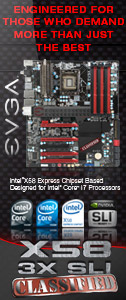«Previous Page 1 2 3 4 5 -View All- Next Page»
The Cooler
Upon unboxing the kit, we were greeted with the mounting hardware already installed onto the heatsink base. We didn’t have a stopwatch at hand but we can guarantee you that it took all but one minute to install. First we placed the backplate under the motherboard and screwed the cooler down from the top using the included spring-loaded screws, all that was left was to slap on the fan bracket. Job done. It’s really that simple and was rock solid afterwards.

The design of the fan attachment is very similar to the TRUE 1366 RT with its clip on method. The Freedom Tower’s fan bracket is easily inter-changeable with regards to fans as the 120mm fan is only attached by plastic clips, so if one wishes to change out the fan to their own choice of fan, it will take you no more than ten seconds.
I can’t stress enough how much of a godsend the mounting is. Be honest, how many of you have gotten to the point of either, a.) throwing your cooler across the room in absolute rage screaming “Lord Jesus” to the useless bits of mounting kit that take an age to work out what goes where or, b.) give up on the mounting altogether and do a botch job and call it a day with the attitude “that’ll do†as the mounting kit supplied is just too over complicated when it doesn’t need to be.
Getting the mounting kit right is critical and should be a priority for all companies concerned. It’s all well and good boasting, “our cooler is the dogs bollocks as its bigger and better than yours with our super copper 8mm heatpipes and uber unique fin designâ€, but in all honesty (fin density and depth aside) all coolers are essentially the same on most levels. Some may have more heatpipes, some thicker than others, or some may have exposed copper bases. At the end of the day, the mounting kit and the flat contact pressure to the CPUs heatspreader is what matters the most. Get that wrong, your super-duper supposedly unique cooler with its impressive specifications will fail miserably. Akasa tick all the winning boxes here as the four nickel coated 6mm copper heatpipes that make contact to the base are machined flat (not smooth though), as is the whole base and nor is it convex, while the mounting was simple, flat, and effective.
Staying on track with the mounting, the kit attached to the cooler out of the box is the Intel mounting for LGA 775/1156/1366. It’s simply a case of choosing one of the three backplates supplied and away you go. For AMD users, all hope is not lost as Akasa supplies the standard reference and very simple AM2/AM3 mounting bridge. This attaches the cooler by the groves cut into its base and to the motherboards stock retention bracket around the socket area. Once again, this takes no more than 15 seconds to mount.
Having been an AMD owner for the past three years, it’s such a delight to come across a premium cooler that supports AMD. Many of the top performance coolers won’t support AMD out of the box due to cost issues and not having the demand. This means many AMD users are often left in the dark having to purchase a ‘lesser’ cooler or buy the separate mounting kit. All these added costs are too much to justify buying, especially if you factor in the cost of wanting your own favorite fan(s), maybe even a fan controller. Again, kudos to Akasa. When codename ‘Bulldozer’ from AMD arrives next year, many of the elite brand names are going to have to step up their game and support AMD users out of the box. Currently, when you think of what premium coolers support AMD straight from the box, you’re left with little choices. Titan’s Fenrir stands out as one of the best, but aside from that and Akasa’s products, your left with not many choices. There is Noctua’s NH-D14 but it costs too much, then there is also the cheap favorite from Coolermaster; the 212 Plus. We really need to see the best premium coolers start to support the AMD market share soon but also do it right whereby mounting the cooler in the preferred vertical orientation (in aid of case airflow), something the Titan Fenrir lacks but sadly the Freedom Tower lacks also.
The 120x25mm fan supplied does feel rather cheap but is to be expected by a sub £30 cooler. The white and black does look rather nice, especially with the added blue tinge LED the 120mm fan provides in each of the four corners. The fan is PWM controlled spinning from a range between 500-1700RPM producing a max airflow rating of 57.32CFM and a maximum 27.18dB(A) noise level. Unlike the other fans used on Akasa’s latest two coolers (S-Flow series), this cooler uses a fan with sleeve bearings rather than HDB (Hydro Dynamic Bearings). This will wear more rapidly than others and considering if your an AMD user, once mounted the cooler with the fan in a horizontal fashion, the fans bearing will wear away even quicker. Whether or not this will have an impact on the noise levels using a sleeve bearing fan, we shall soon see. However, the fans’ cabling is braided nicely.











